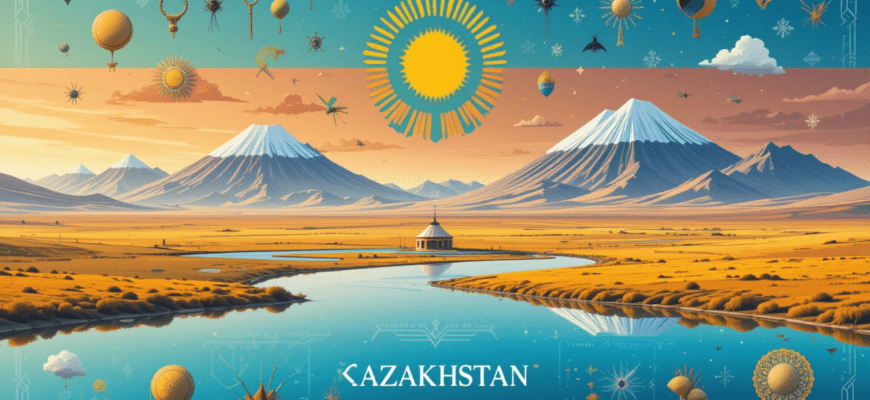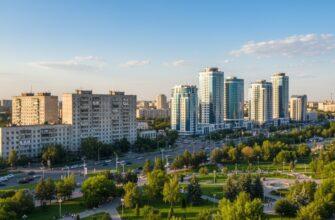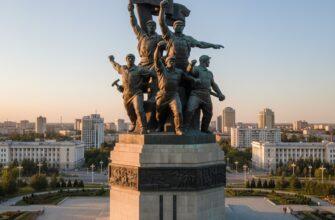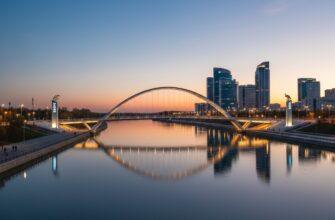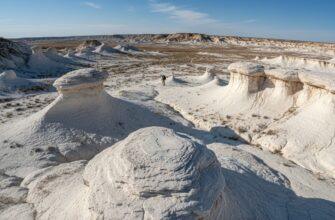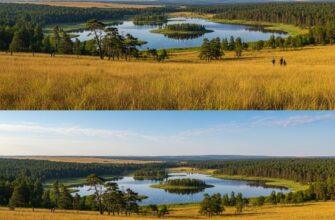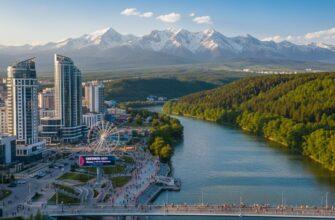
Key Highlights
- Kazakhstan is a transcontinental country located in Central Asia and extending west of the Ural River.
- It is the world’s largest landlocked country, encompassing a diverse landscape from steppes to mountains.
- Rich in history and culture, Kazakhstan was a significant stop on the ancient Silk Road.
- The country gained independence from the Soviet Union in 1991.
- Today, Kazakhstan is known for its oil reserves and growing economy.
Introduction
Is Kazakhstan a city? This simple question can cause confusion. Located in Central Asia, Kazakhstan is much more than just one city. It is a large country with a rich mix of culture, history, and beautiful landscapes. In this exploration, we will clear up this misunderstanding and show what Kazakhstan is really about.
Clarifying Common Misconceptions
The confusion about Kazakhstan’s identity probably comes from not knowing much about its geography and role in the world. Many people might not have had the chance to learn in detail about this Central Asian country.
It’s important to know the difference between a city and a country. A city is a town in a country, but a country is a self-governing area with its own borders. Kazakhstan clearly fits into this second category.
Kazakhstan’s Geographical Identity
The Republic of Kazakhstan is located in Central Asia. It is the largest landlocked country in the world, even bigger than Western Europe. This size gives Kazakhstan many different landscapes, including the tall Altay Mountains and the dry Kazakh Steppe, which experiences cold winters.
Because it sits at the crossroads of Europe and Asia, Kazakhstan is considered transcontinental. This means it covers parts of both continents. This special location has influenced Kazakhstan’s history, culture, and politics for many years.
If you’re asking, “Is Kazakhstan a city?” the answer is no. Kazakhstan is a country with its own unique geography and a rich culture just waiting to be explored.
City or Country: Understanding the Basics
The main point is simple. The Republic of Kazakhstan is a sovereign state. This means it has full political freedom and control over its land. Like other countries, it has set borders, manages its own matters, and interacts with other nations.
Cities live within these country borders. They are places where many people live, often acting as centers for business, culture, and government.
The difference is clear. The Republic of Kazakhstan covers a large area, has different environments, and includes many cities inside its borders.
Kazakhstan’s Place on the Map
Now that we know Kazakhstan is a country, let’s find out where it is. Picture a map of Asia and look towards the center. You will see Kazakhstan there. This large country is next to Russia, China, Kyrgyzstan, Uzbekistan, and Turkmenistan, showing its important location.
Kazakhstan’s location is also important for more than just being near other countries. It has a key role in politics and global trade. We will look into that more later.
Geographic Location and Size
Kazakhstan covers a huge area of 2.7 million square kilometers. This makes it the ninth-largest country in the world. To imagine its size, think about fitting all of Western Europe inside it.
In Central Kazakhstan, you can find many different landscapes, including Lake Balkhash. There are rich plains perfect for farming and rugged mountains. The country has a lot of arable land, which helps its farming industry grow. Kazakhstan also shares a border with the Caspian Sea. This is the largest inland body of water in the world, showing how important the country is in the region.
These geographical features have played a big role in shaping Kazakhstan’s history, economy, and its relationships with other countries.
Neighboring Countries and Borders
Kazakhstan was once part of the former Soviet republic, the Soviet Union, and became independent in 1991. Today, its borders, mostly taken from its Soviet history, are important for its relationships with neighbors. It shares borders with five countries, all from the former Soviet Union.
These borders are not just lines on a map. They are important for trade, culture, and diplomatic ties. Kazakhstan works closely with other Central Asian countries on key issues that matter to the region.
The shared history and the links between their economies mean that these borders will still be important for Kazakhstan’s future.
Delving into History
Kazakhstan has a long and interesting history. It is full of cultural influences that mix together over many years. The journey of this country started with the Kazakh Khanate. It has seen the times of Soviet rule and now stands as a modern republic. Events like Genghis Khan’s battles, the famous Silk Road, and its important location make Kazakhstan vital to Central Asia’s history. The change in writing from Arabic script to Cyrillic and back to the Latin alphabet shows how its history has moved. When we look closely, we see a rich and varied past filled with conquests and change. This has helped shape Kazakhstan into the diverse place it is today.
From Nomadic Tribes to a Sovereign State
The Kazakh Khanate became a notable political group in the late 15th century. This was an important time for the Kazakh people as they began to form a unified identity. The khanate covered much of what is now Kazakhstan and grew powerful in the region. However, by the early 17th century, it faced problems from within and outside. This caused the khanate to split into three different groups known as “Zhuzes” or hordes.
Even with this division, the Kazakh people kept a strong sense of their shared culture and history. Their nomadic lifestyle and connection to the land shaped how they lived for many years.
In the years that followed, the Kazakh people dealt with complex ties to nearby empires. Eventually, they came under Russian control. Kazakhstan’s journey reached a high point in 1991 when it became an autonomous republic and gained its long-desired independence as a separate country.
The Silk Road and its Impact on Kazakhstan
Kazakhstan has a rich history linked to the old Silk Road. This was a series of trade routes that connected the East and the West for more than 1,500 years. Kazakhstan was a key part of this network. Because of this, it saw a lively exchange of goods, ideas, and cultures. Cities like Otrar and Taraz became important centers for trade.
The Silk Road brought a lot of wealth and prosperity to the area. This helped drive economic growth and cultural sharing. The nomadic people of Kazakhstan, known for their skills with horses and their understanding of the steppes, played an important part in making trade happen along these pathways.
Today, the impact of the Silk Road is still seen in Kazakhstan’s identity. Its position is important and its focus on global trade shows how it has helped connect different parts of the world throughout history.
Soviet Era and Independence
The 20th century brought big changes to Kazakhstan when the Soviet rule started with the rise of the communist party. Kazakhstan joined the USSR in 1920. During this time, it quickly industrialized and changed its society, including the displacement of groups such as the Crimean Tatars. The country helped the Soviets, especially in World War II. It became an important place for moving industries and providing useful resources.
But the Soviet period had its problems too. Forced collectivization caused a lot of hunger. Also, efforts to stop Kazakh culture and language led to pushback.
In 1991, the Soviet Union collapsed, starting a new time for Kazakhstan. It announced its independence and began building its nation and economy. Nursultan Nazarbayev, the first president, was key in helping Kazakhstan make this change.
Political Landscape
Since it became independent in 1991, Kazakhstan has made important changes to its political system. It is now a presidential republic, as established by the president of Kazakhstan, with several political parties, showing a shift from its Soviet history.
The government is crucial in steering Kazakhstan’s economic and social growth. It wants to make the country an important player in the region.
Government Structure and Democracy
The government of the Republic of Kazakhstan focuses on a president as the head of state, while the prime minister assists in this role. Nursultan Nazarbayev was the president from independence until 2019 and previously served as foreign minister. He had a big part in creating Kazakhstan’s political system and guiding its growth.
Still, Kazakhstan has faced criticism from international groups, as highlighted in the World Factbook. They point out issues with human rights and the country’s practices in democracy. As Kazakhstan grows, there are efforts to improve political systems and make democratic institutions better. These changes hope to create a fair balance of power, increase transparency, and give people a stronger voice in government.
Kazakhstan’s journey to a more democratic system will take time. It will require ongoing talks and changes to its political setup.
Kazakhstan’s Role in International Politics
Kazakhstan takes a balanced approach to its international relations. It wants to build connections with countries all over the world. Kazakhstan is an active member of the United Nations and many other global groups.
In its foreign policy of the country, Kazakhstan focuses on economic diplomacy. It aims to get foreign investment and boost trade partnerships. The country also acts as a mediator in regional conflicts to help keep Central Asia stable.
With a growing economy and a key location, Kazakhstan has a louder voice in international matters. Its efforts to connect with the global community will likely shape its role in world politics in the future.
Economic Overview
Kazakhstan came out from the shadow of the Soviet Union following the collapse of the Soviet Union and started to grow its economy. It is now an important player in the global market, partly due to the support and guidance of the International Monetary Fund. The economy has grown a lot, thanks to its natural resources and smart changes made in its policies.
Kazakhstan’s economy shows how it has shifted from a planned system to one that focuses on market ideas. This makes it an interesting example of countries that are starting to develop.
Major Industries and Economic Contributors
The World Bank sees Kazakhstan as an upper-middle-income country. This shows its strong economic growth since it became independent. A lot of this success comes from its natural resources.
Kazakhstan is a big player in the global energy market. It has large reserves of oil and natural gas. The country also has important amounts of uranium, copper, and other minerals. This makes mining very important for its economy.
Agriculture is also very important. Kazakhstan grows a lot of wheat and other crops. These products help its people and are also sent abroad. The country is working hard to mix its economy, not just focusing on energy. It is also looking to grow parts like manufacturing, tourism, and technology.
The Role of Oil and Natural Gas
Kazakhstan is one of the countries with the most oil reserves in the world, holding a significant amount of proven oil reserves, approximately 30 billion barrels of proven oil and billions of cubic metres of gas. Finding and developing big oil fields, especially near the Caspian Sea, has helped boost Kazakhstan’s economic growth.
The country is a major oil producer and a big exporter too, mostly to Europe and Asia. Money from oil and natural gas sales is very important for Kazakhstan’s economy. It helps the government fund infrastructure, education, and social programs.
However, because Kazakhstan relies so much on oil and natural gas, its economy can be affected by changes in global energy prices. To address this risk, the government is working to diversify its energy sources, looking into renewable energy and ways to improve energy efficiency.
Agriculture and Livestock
Agriculture is an important part of Kazakhstan’s economy. It has a long history and is a big part of its culture. The country has a lot of arable land. This land is mainly used to grow wheat, barley, and other grains. Kazakhstan’s fertile steppes are also good for livestock. They focus on raising sheep, cattle, and horses.
Even though the energy sector is becoming stronger, agriculture still provides jobs for many people. This is especially true in rural areas. The government knows that modernizing agriculture is crucial. They are putting money into technology and infrastructure to help farmers be more productive and raise better-quality goods.
Kazakhstan wants to do more than just meet its food needs. It aims to be a big agricultural exporter, looking to sell its products in regional and global markets.
Trade Partners and Economic Policies
Kazakhstan is involved in international trade and wants to grow its economic ties around the world. The main countries it trades with are China, Russia, and the European Union. Being a part of the Eurasian Economic Union (EEU) and the customs union helps Kazakhstan work better with its neighbors. This makes it easier to move goods and services within the group.
Kazakhstan’s policies focus on inviting foreign investment and making it easier to do business. The government is working on changes to simplify rules, attract foreign direct investment, and support small and medium-sized enterprises (SMEs).
As Kazakhstan builds its economy, its trade deals and economic policies will be very important for its future. The country’s position between Europe and Asia, along with its rich resources, makes it likely to play a big role in the global economy.
Cultural Tapestry
Kazakhstan has a rich and varied culture that matches its geography. Its history, nomadic ways, and different cultures meeting on the Silk Road have all shaped it. You can find a mix of old traditions and new ideas here.
The friendly people and the lovely music and art make exploring Kazakhstan’s culture a rewarding journey.
Ethnic Diversity and Languages
Home to over 19 million people, Kazakhstan has many ethnic groups. Ethnic Kazakhs are the biggest part of the population. However, the country has a rich mix of cultures.
You can see the influence of Russian culture, due to Kazakhstan’s history with the former Soviet Union. Other ethnic groups, like Uzbeks, Ukrainians, Germans, Tartars, and more, also add to the cultural mix. This diversity can be seen in the languages spoken in Kazakhstan.
The Kazakh language is official, but Russian is also commonly used. This shows the historical connection between the two countries. The use of both languages reflects Kazakhstan’s effort to keep its culture, while also recognizing its complex past and present.
Traditions and Cultural Practices
Kazakh traditions are closely linked to the country’s history of nomadic life. Horses have been important in Kazakh culture for centuries. Horse riding, falconry, and hunting with eagles are not just old customs; they are valued traditions passed down through many generations.
Hospitality is also very important in Kazakh culture. People warmly greet their guests and offer tea and traditional foods like “beshbarmak” (a meat and noodle dish) and “kumys” (fermented mare’s milk). These practices show Kazakhstan’s nomadic roots and highlight the value of community, nature, and keeping ancestral traditions alive.
Even with fast changes and urban growth, Kazakhstan stays connected to its nomadic background. Keeping these traditions alive is seen as essential for preserving the country’s cultural identity and sharing its unique heritage with future generations.
Modern Kazakh Society
Under Nursultan Nazarbayev’s leadership, Kazakhstan made bold modern changes after gaining independence. The focus was on growing the economy and building cities in virgin lands. New places, like Astana, now called Nur-Sultan, were created. These cities are known for their modern designs and planning.
This push for modernization led to big changes in Kazakh society. Today, you can see a lively blend of tradition and modern life. Many people in Kazakhstan enjoy modern ways of living, but they also hold tight to values like family, community, and respect for older generations.
Kazakhstan’s society now reflects a country going through fast changes. It welcomes new ideas from around the world, but it also wants to keep its unique culture and traditions safe.
Architectural Wonders
Kazakhstan’s buildings show two worlds: the old and the new. You can see pieces of its Silk Road history next to new buildings that represent the country’s hopes for the future.
There are mausoleums and minarets along with futuristic skyscrapers and unique designs. Exploring Kazakhstan’s architecture takes you on a trip through time.
Ancient Architecture and Historical Sites
Journey back in time as you explore old cities that were along the Silk Road. Places like Otrar, Taraz, and Turkestan show us what life was like when trade and culture were thriving. These cities have beautiful examples of Islamic buildings, with fancy mausoleums, tall minarets, and old mosques.
One well-known site is the Mausoleum of Khoja Ahmed Yasawi in Turkestan. This UNESCO World Heritage Site is famous for its stunning beauty. Built in the 14th century, this mausoleum is a great example of Timurid architecture. It shows Kazakhstan’s rich history and building skills.
These historical sites are not just old stones. They are windows to a lively past when Kazakhstan was important in connecting the East and the West, as shown on the official website of the cultural heritage. They remind us of the country’s lasting importance and cultural role in the world.
Contemporary Buildings and Urban Development
Under Nursultan Nazarbayev’s plan for a modern Kazakhstan, the cities changed a lot. Astana, the capital city and seat of the government of Kazakhstan, became a strong symbol of this change. It was designed by famous architects and has futuristic skyscrapers, wide streets, and well-known buildings like the Bayterek Tower and the Palace of Peace and Reconciliation.
These buildings show Kazakhstan’s dreams for the future. They reflect a nation that looks forward and embraces new ideas. The quick development of cities has changed the skyline and shows the country’s economic growth. Kazakhstan wants to be a key player in the region.
Modern buildings in Kazakhstan show the country’s goal to create fresh and lasting urban spaces. These structures mix traditional designs with new ideas, shaping the country’s growing urban character.
Natural Wonders of Kazakhstan
Kazakhstan is not just known for its amazing buildings. It also has beautiful and different types of nature. You can find tall snow-covered mountains, clear lakes, wide open steppes, and interesting deserts. Seeing the natural beauty of Kazakhstan is truly amazing.
These different landscapes are home to many plants and animals. They also offer lots of chances for adventure. This makes Kazakhstan a place that nature lovers should really visit.
Unique Landscapes and Ecosystems
Kazakhstan covers a huge area with many different landscapes and ecosystems. In the east, the Altay Mountains rise high into the sky. They provide amazing views and are great for hiking and trekking, especially during the hot summers. The open steppes play a role in showing the country’s nomadic history.
However, Kazakhstan has environmental problems, especially with the shrinking Aral Sea and the Syr Darya river sources. This lake, which used to be the fourth-largest in the world, has shrunk a lot because water is taken for irrigation in the area.
The situation of the Aral Sea reminds us how important it is to manage water well and protect the environment. Even with these issues, Kazakhstan’s natural beauty is a big part of what makes the country special. It attracts visitors from all over the world.
National Parks and Conservation Areas
Kazakhstan understands the need to protect its natural heritage. Because of this, it has created many national parks and conservation areas. These protected places keep different ecosystems safe and serve as homes for rare and endangered animals.
Burabay National Park is a well-known spot with beautiful lakes, forests, and interesting rock formations. Kolsai Lakes National Park attracts visitors with its clean alpine lakes. There, you might see wildlife like snow leopards and ibex.
Kazakhstan does not stop at just these parks. The country also works with others around the world to fight big environmental problems like climate change and desertification.
The Heart of Central Asia
Kazakhstan sits in the middle of Central Asia. This makes it an important part of a region that is changing a lot. Its role is more than just being in the center. Kazakhstan uses its power in politics and the economy to impact the area around it.
As Central Asia faces many challenges, what Kazakhstan does will help shape the future of the region.
Strategic Importance and Regional Influence
Kazakhstan is very important in Central Asia for many reasons. Its location connects major countries like China and Russia. This makes it central to trade and transportation in the area. Kazakhstan has large energy resources and a growing economy, which gives it power in regional matters.
In addition, being a member of the Shanghai Cooperation Organisation (SCO) shows how it helps improve regional safety and encourages talks about common problems.
Kazakhstan works hard on diplomacy and focuses on economic growth. This has allowed it to have great influence in Central Asia. As the area changes, Kazakhstan’s importance is likely to increase even more.
Kazakhstan’s Contributions to Central Asian Stability
Kazakhstan has become a strong supporter of peace and stability in Central Asia. It is working hard to solve regional conflicts and encourage talks between nearby countries. Its efforts in mediating issues and helping others to work together are key for keeping balance in a region that often faces tensions.
Moreover, as a member of the Organisation of Islamic Cooperation (OIC), Kazakhstan helps to connect different groups and build understanding between Islamic and Western countries. Its focus on open talks and tolerance helps keep both the region and the world more stable.
Kazakhstan’s active diplomatic actions and its aim to improve economic ties show its commitment to making Central Asia safer and more successful.
Educational System
Kazakhstan understands that education is key to a successful future. Since becoming independent, the country has worked hard to improve its education system. They are putting a lot of money into better schools and making sure everyone can access good education at every level.
Kazakhstan’s focus on education goes beyond just raising literacy rates. It aims to build a skilled workforce that can help lead the country to a better future.
Schools and Higher Education
Kazakhstan’s government has started changes to modernize schools and improve education standards in the country. These changes include updating lessons, using new teaching methods, and giving schools modern technology. This helps create a more interactive and interesting learning experience.
In higher education, Kazakhstan has seen a big growth in universities and learning institutions. The government knows it needs a skilled workforce for a knowledge-based economy. So, they focus on developing STEM fields and encouraging new ideas and businesses among graduates.
Kazakhstan wants to improve education not just at home but also beyond its borders. The country has set up scholarship programs to attract international students and promote academic exchange. These efforts show that Kazakhstan believes investing in education is essential for its growth and development.
Research and Technological Advancements
Kazakhstan knows that technology is key for being competitive in the economy today. So, it is working hard to boost research and tech progress. The government has set up science parks, tech incubators, and research centers. These help to bring in foreign investment in high-tech areas and support new ideas.
Kazakhstan is focusing on technology in many fields like renewable energy, information technology, and space exploration, particularly around the Baikonur Cosmodrome space launch facility. The country is partnering with other countries on space projects and wants to start its own space industry.
Kazakhstan is dedicated to research and technology. This push is helping create a culture where innovation thrives. It is shifting towards a knowledge-based economy, so it can compete better in the world.
Kazakhstan in the Global Arena
Kazakhstan has worked hard to find its own spot in the world since it became independent. It is involved in international issues and has a careful foreign policy. The country is now a respected part of the international community and adds to global conversations.
Kazakhstan cares about working with others and aims to build good connections with countries everywhere. This shows that it knows how connected our world is today.
International Cooperation and Alliances
Kazakhstan strongly supports working with other countries, including the United States. It actively participates in groups that tackle global issues. Being a member of the United Nations, the Organization for Security and Cooperation in Europe (OSCE), and the Shanghai Cooperation Organisation shows its dedication to teamwork.
Kazakhstan always promotes diplomacy and peaceful discussions to solve problems. It aims to help create a safer world. The country has also helped mediate regional disputes and push for nuclear disarmament and prevention.
Its involvement in international groups and focus on global peace have made Kazakhstan a trusted partner in international matters.
Kazakhstan and the United Nations
Kazakhstan shows its commitment to working with others through its involvement with the United Nations and its groups. The country always tries to support the goals set out in the UN Charter. It is also a strong backer of the UN’s Sustainable Development Goals (SDGs).
Human rights are important for Kazakhstan in its international connections. The country has been part of the UN Human Rights Council. This shows that it wants to talk about human rights issues and work on improving and protecting them.
Kazakhstan plays a positive role in the United Nations. Its focus on working with different countries shows it is dedicated to using international law and diplomacy to tackle global problems.
Sports and Recreation
Kazakhstan loves sports, and this shows in both traditional games and global competitions. These sports are a big part of the country’s culture. Athletes from Kazakhstan have gained recognition around the world.
But it’s not just about sports for professionals. Kazakhstan also values sports and fun activities for its people. They promote being active and healthy as important parts of life.
Traditional Sports and International Competitions
Rooted in their nomadic history, traditional Kazakh sports like horseback riding, archery, and wrestling are still popular today. These sports are not just activities. They show the strength, skills in horsemanship, and a strong bond with nature in Kazakh culture.
Kazakhstan has also done well in different international sports. Athletes from Kazakhstan have shined in boxing, weightlifting, and cycling. They show their skills and hard work on the world stage. The country has even hosted major international sports events like the Asian Winter Games. This shows their efforts towards sports.
Kazakhstan’s focus on promoting sports and taking part in international competitions helps bring national pride. It also leads to a healthier nation.
Promoting Health and Wellness through Sports
Kazakhstan understands how important sports and physical activity are for health and happiness. The country is working hard to encourage an active lifestyle among its people. They have spent money on building sports facilities, like stadiums and recreational areas, to ensure everyone can be active.
Kazakhstan also promotes participation in many sports events. This includes marathons, cycling races, and community fitness programs. These events help bring families together and create a shared love for being active.
By focusing on health and wellness through sports, Kazakhstan shows it cares about the well-being of its citizens. They believe that a healthy nation can achieve great things. That is why they stress adding physical activities and recreation into everyday life.
Tourism and Hospitality
Kazakhstan is an interesting place for many travelers. It has a mix of history, nature, modern cities, and lively culture. This variety offers adventure and culture that many people enjoy.
Kazakhstan knows tourism is important. Because of this, they are working hard to improve their tourist services and bring in more visitors from all over the world.
Destinations for Every Traveler
Kazakhstan has many places to explore, whether you want adventure, culture, or history. People who love adventure will enjoy the mountains. Here, you can hike through beautiful scenery, ski, or ride horses across the vast steppes.
Cities like Almaty, the former capital, and Nur-Sultan, a modern city, offer a lively blend of culture and history. Visitors can check out museums, art galleries, and busy markets. This gives them a chance to see and feel Kazakhstan’s rich culture.
If you love history, Kazakhstan has UNESCO World Heritage Sites that will catch your interest. The old city of Turkestan has grand mausoleums and mosques. You can also explore parts of the Silk Road, which shows how important this country was in the past.
Growth of the Tourism Industry
Kazakhstan is making great progress in building its tourism industry. The country sees how tourism can help with economic growth and create jobs, especially in the Commonwealth of Independent States (CIS). The government is putting money into better infrastructure, improving transportation, and making the tourist experience better.
There are also more efforts to attract foreign investment in tourism. International hotel chains are setting up in Kazakhstan, and new resorts are being created for the rising number of visitors.
Kazakhstan’s tourism industry is still growing, but it shows a lot of promise. With its many attractions, friendly people, and ongoing improvements to services, Kazakhstan is ready to become a popular spot for travelers from all over the world.
Cuisine and Gastronomy
Kazakh cuisine has roots in its nomadic history and shows the tastes of Central Asia. It takes you on a tasty journey. You will find hearty meat dishes, rich stews, and special dairy products that are unique to the area. Trying foods from Kazakhstan is a truly exciting experience.
As Kazakhstan becomes more connected to the world, its food is also getting more attention. Chefs are mixing traditional recipes with modern ideas to create new dishes.
Traditional Dishes and Culinary Influences
Kazakh food is mostly about meat, especially lamb and horse meat. This shows the country’s nomadic history where animals were very important. The national dish is called “Beshbarmak.” You should try it! It has boiled meat, usually horse or lamb, served on noodles. It often comes with a tasty broth.
Dairy products are also important in Kazakh dishes. “Kumys” is a drink made from fermented mare’s milk. It is refreshing and is thought to be good for health. Other traditional meals are “plov,” a rice dish with meat and vegetables, “manti,” which are steamed dumplings, and “baursaki,” tasty fried dough.
Kazakh cuisine has been influenced by nearby cultures. It mixes flavors from Uzbek, Russian, and Uighur cooking styles. This mix makes it a special and unique food experience.
Modern Kazakh Cuisine
As Kazakhstan’s food culture changes, chefs and food lovers are trying new ways to remake traditional dishes. They are mixing these recipes with international tastes and modern cooking techniques.
Today’s Kazakh cuisine often uses lighter cooking methods. Chefs focus on creative plating and using fresh, local ingredients. High-end restaurants in cities like Almaty and Nur-Sultan are setting new standards. They show the variety and richness of modern Kazakh food.
This change in cooking styles shows that Kazakhstan wants to welcome global influences while staying connected to its cooking history. The result is a food scene that feels both familiar and exciting.
Art and Literature
Kazakhstan’s art and literature show the true essence of the nation. They reflect its deep history, cultural roots, and the changing identity of its people. From detailed crafts and engaging stories to new forms of art, Kazakhstan’s creativity captures our imagination.
The artistic traditions that have been shared through many generations still inspire today. At the same time, new artists and writers are adding fresh ideas. This creates a lively and changing art world.
Historical Significance of Kazakh Art
Kazakh art shows the history of the country’s nomadic lifestyle. It often includes themes inspired by nature, animals, and traditional crafts. The carpets and textiles are detailed and colorful. They are known for their bright colors and geometric patterns. These pieces have always played an important role in Kazakh culture.
Contemporary Artists and Writers
Explore Kazakhstan’s lively culture. Here, today’s artists and writers greatly influence the artistic scene. You can find thought-provoking books and innovative art shows. These creators represent the country’s diverse society and rich history. They are shaped by the nomadic past and the Soviet era. These influences help them present unique views on today’s challenges and hopes. Check out the works of Kazakhstani poets, writers, and visual artists. They tackle social issues through their art. Their creativity captures the heart of this vibrant Central Asian nation. The artistic community in Kazakhstan plays a key role in sharing the country’s cultural identity with the world.
Music and Performing Arts
Kazakhstan has a lively culture full of music and performing arts. Traditional Kazakh music comes from a nomadic background. It is known for its unique sound and ability to tell stories. Instruments like the dombra and kobyz are important in this music. They mix ancient sounds with modern styles, creating a blend of cultures. Today, new artists attract audiences by combining traditional music and worldwide trends. This shows how music in Kazakhstan has grown and is recognized worldwide. The music reflects the rich and diverse culture of the country.
Traditional Music and Instruments
Kazakhstan has a deep history of traditional music and instruments. The dombra is a two-stringed lute that is very important in Kazakh culture. Its sounds fill the wide steppes and show the country’s musical past. The dombra also represents the nomadic lifestyle of the Kazakhs. Other instruments, like the kobyz, which is played with a bow, bring feeling to the music and show the spirit of Kazakhstan’s music. These instruments are not just for entertainment; they help keep the history of Kazakhstan’s music alive for future generations.
Modern Music Scene
The modern music scene in Kazakhstan is lively and mixes old traditions with new styles. New artists are putting together Kazakh folk music and genres like pop, rock, and electronic music. They focus on their culture and use music to show off their rich history while also trying new sounds. Streaming services and social media platforms help independent artists grow, connecting them with listeners all over the world. This exciting music scene shapes Kazakhstan’s culture and brings attention to its changing music industry.
Media and Communication
Exploring media and communication in Kazakhstan shows a complex picture shaped by history and politics. The country has made progress in press freedom, but challenges still exist. President Nazarbayev’s legacy affects media policies today. Meanwhile, President Tokayev is dealing with changing digital media trends. Kazakhstan’s role in the international arena also influences its media strategies. The media landscape includes both traditional outlets and digital platforms, reflecting the country’s vibrant society. To understand media in this Central Asian nation, we need to consider both its history and its future goals.
Press Freedom and Media Landscape
Press freedom in Kazakhstan is a big concern. Human rights groups have pointed out the limits on media freedom. The government controls many aspects of the media, making it hard to share information. Even though the constitution supports a free press, journalists struggle with censorship and lawsuits. The government controls many media outlets and has strict laws, which leads to very little independent journalism. International groups have noted the lack of different opinions and voices in the media. The media situation in Kazakhstan is being watched closely for any changes that could improve it.
Digital Media and Internet Usage
Kazakhstan is moving forward in digital media and internet use. The people are tech-savvy, and more and more are getting online. The government wants to improve internet access in both cities and the countryside to help everyone join in the digital world. Social media is very popular and helps people talk and share information easily. There are also more online news sites and content being created, showing how media is changing. As Kazakhstan grows in its digital changes, it is working hard to keep the online space safe and inclusive for all users.
Environmental Policies
Kazakhstan is working hard to grow its economy while also taking care of the environment. The country faces some tough challenges like using its oil reserves and dealing with pollution from industries. Despite this, Kazakhstan is committed to protecting the environment. The nation is introducing plans to use more renewable energy and tackle issues related to water scarcity. In addition, Kazakhstan is teaming up with international partners to conserve nature. Although the country has a vast land area and many different ecosystems, the government has set high goals to improve how it cares for the environment. President Tokayev’s administration is focused on green policies to help create a better future.
Challenges and Initiatives
Kazakhstan is working toward growth, but it faces many challenges. Environmental problems are important, arising from past actions and current industries. The country wants to find sustainable solutions. They aim to grow the economy while also protecting the environment. Working with others around the world is key to addressing these problems. Kazakhstan cooperates with global partners to use their knowledge and resources for better outcomes. By focusing on specific projects and committing to advancement, Kazakhstan aims to overcome challenges and create a brighter, more sustainable future.
International Collaboration for Environmental Protection
Kazakhstan has worked hard on environmental protection over the years. The country has partnered with groups like the United Nations and the World Bank. These partnerships have helped Kazakhstan develop sustainable practices. They have played a key role in tackling environmental issues and starting conservation programs. Kazakhstan’s work supports global efforts on climate change and protecting biodiversity. This shows the country’s promise for a greener future. By taking part in meetings and agreements about the environment, Kazakhstan helps achieve important goals for sustainability and ecological balance worldwide.
Conclusion
NLP technology is changing many parts of Kazakh society. This includes areas like media and environmental efforts. Kazakhstan is an important country in Central Asia. Its rich history and diverse culture create a special setting for understanding its role in the world today. When we look at the country’s past and present, we see that Kazakhstan is more than just a city. It is a blend of tradition and new ideas. The country is ready to make big moves in art, music, government, and caring for the environment.
Frequently Asked Questions
Is Astana the Largest City in Kazakhstan?
Astana was the capital city of Kazakhstan until 2019, which is located near western Kazakhstan. That year, it was renamed Nur-Sultan. Almaty is the biggest city in Kazakhstan. It is famous for its rich culture and lively atmosphere. Astana, now called Nur-Sultan, is the nation’s administrative center. It features modern buildings and rapid urban growth.
How Does Kazakhstan’s Economy Compare to Other Central Asian Countries?
Kazakhstan has the biggest economy in Central Asia. This is because it has a lot of natural resources, like oil and gas. These resources help it grow more than its neighbors. This leads to better growth and development projects.
Can Tourists Experience Nomadic Culture in Modern Kazakhstan?
Discover the vibrant nomadic culture of today’s Kazakhstan by trying out unique experiences for visitors. Join in on traditional customs, stay in yurts, and enjoy horseback riding. This will help you mix old practices with new understandings of the nomadic lifestyle.
What Are Kazakhstan’s Major Exports?
Kazakhstan mainly exports oil, natural gas, metals, and farm products. The nation is famous for its strong energy resources and various agricultural goods. These exports play a big role in boosting the economy.
How Safe Is Kazakhstan for International Visitors?
Kazakhstan is safe for international visitors. It has a low crime rate and friendly people. Tourists can see many different landscapes and enjoy the rich culture without worry. Travelers should still remember to follow basic safety tips to have the best time in Kazakhstan.

